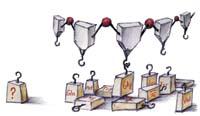Amino acid 21

You are alive. The most surprising thing is that millions of chemical reactions are occurring in your cells, which would not actually occur under normal conditions. But life is not a normal condition, fortunately being alive means that we have proteins for these reactions to occur.
What do proteins have special? In short, its ability to perform virtually any chemical reaction. The cells of the body are small chemical laboratories and proteins are the chemicals of the laboratories. They control, individually or collectively, all the molecules of metabolism. There are everything: acids, bases, water soluble molecules, not soluble in water, neutral, charged, etc. It is easy to understand that proteins must be prepared for almost any chemistry that allows to control all these molecules.
And they are prepared. Proteins are long chains of amino acids united by special molecules. Depending on the amino acid sequence, a certain protein will do one job or another. Therefore, for there to be many different proteins, one can think that there are many types of amino acids. But no. There are only twenty, all the chemistry that needs life is summarized in twenty molecules.
It's like the lost island game. What three things would you take to a lost island? If you give practical sense, it is a difficult game, what are the three things necessary to survive on an island? Very difficult. It's a complaining game, why only three things?
Here too, what amino acid would you include in cell proteins to survive? For only twenty amino acids are necessary, the usual twenty. Some are hydrophilic, other hydrophobes, some acids, some basic, some aromatic, other aliphatic, etc. But with twenty is completed the need of life from a chemical point of view.
Selenio
Only twenty. In 1986, however, the twenty-first selenocysteine was discovered.
In fact, it is a variant of one of the twenty "selected"; cysteine is practically equal to the amino acid, but it has a selenium atom instead of a sulfur atom. Selenocysteine is introduced in proteins only by some living, not by all. Therefore, the debate arose. Would the list of twenty have to be added another or not?
The presence of a selenium atom in an amino acid brings some advantages to the chemistry of life, something that no one questioned. It is a good donor of protons, ideal to neutralize free radicals, for example. But then, why was there no selenocysteine in all living things? We do not know his answer.
To know if it is necessary to include it in the list of amino acids of proteins, the genetic code can be consulted. In short, the genetic code is a code of amino acids. In the molecular sequence of DNA, each amino acid is encoded by three consecutive nucleotides. And as there are four types of nucleotides, there are 64 combinations (64 codons); for a group of twenty, enough and leftover.
Encoders are not only twenty, since they also encode the beginning and end of the sequence. However, as they are 22, it seems that there are over 42 codes. But it is not true. Of the twenty amino acids, nineteen are encoded by more than one. The protection against mutations is a great advantage.
The question is that selenocysteine does not have its own elbow. When it appears it uses the same code as the final signal, along with other special signals.
As we have said, it does not appear in all living beings... if we have looked at it well. It seems that it can also appear in some human proteins. In the human genome project this possibility was not taken into account, but every time they found that codon was considered the end of a gene. Most of the time it is like this, but in some cases it can be the codon of selenocysteine.
And while some scientists analyze the presence of selenium in human proteins, others find a twenty-two amino acids in other living things, pyrolysine. Have we started again?





